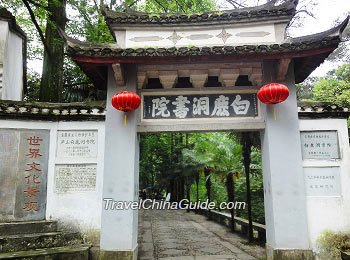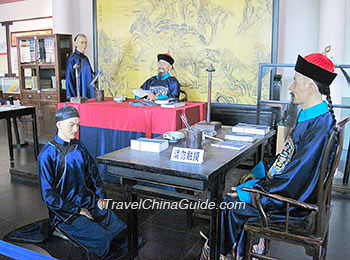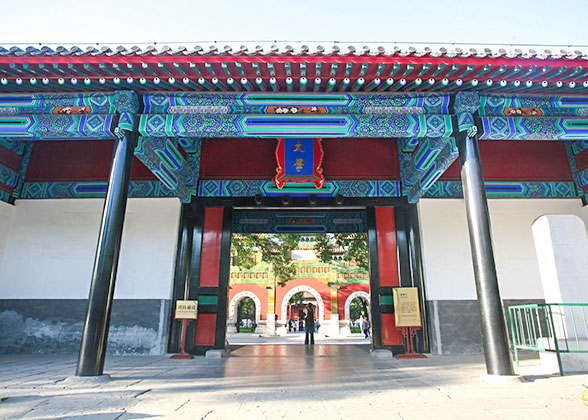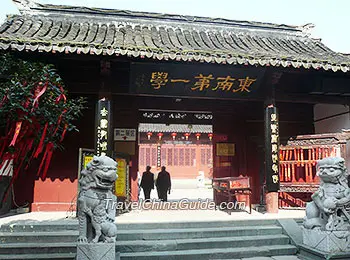Innovation of Education in Ming & Qing Dynasties
Innovation in Education System
 |
| Bailudong Institute in Mt.Lushan, Jiangxi, greatly developped in the Song Dynasty |
Firstly the extension of matriculation was broadened. In the former dynasties like the Tang Dynasty, each year the 'jinshi' were no more than twenty to thirty in number but in the Song Dynasty, there were as many as hundreds of people passing the exams and even those who failed the exams many times could apply for tolerance of the emperor and so serve as officials with less important positions.
Secondly, the frequency of exams was limited to a fixed 'once every three years'. The local tests came first in autumn and in the following spring the qualifying candidates would trudge to the capital for the higher imperial examination.
Thirdly, so far as content was concerned, while the earlier examinations laid much stress on the ancient classical texts, the great reformer Wang Anshi (1021 - 1086) advocated an innovation which was much more practical. He changed the blank-filling of verses into composition about the verse, giving free reign to the ability of the candidates. However this was opposed by other grandees and did not last for long.
Finally, to prevent the practice of favoritism, examinees' names were closely covered on their papers which were then exchanged among different local examiners. This did indeed greatly reduce the incidence of cheating.
In the Song Dynasty, few governmental schools were erected, but it was the vogue for scholars to set up numerous private educational organizations - 'shu yuan'. The function of this kind of school was to cultivate talented people, to encourage a devotion to learning, as well as to spread culture. The four most reputed 'shu yuan' were named Bailudong Institute of Jiangxi, Songyang Institute and Yingtianfu Institute of Henan, and Yulu Institute of Hunan. Scholars were invited to give lectures and students were provided with dormitories, desks and food while basically studying on their own. Subsequently, most of these institutes became places where students prepared for exams.
Full-Bloom in the Ming Dynasty
With the coming of the Ming Dynasty, the imperial examination system reached its period of full bloom. Great attention was given to the administrative procedures and the tests became more rigorous.
Central government managed to found schools called 'guozijian', and strengthened their function to be the only road by which people could take the exams. There were in total three stages leading to realizing the dream of becoming an official: provincial examination (xiangshi), metropolitan examination (huishi) by the Board of Rites, and Palace examination (dianshi) by the emperor himself. Only students of 'guozijian', commonly known as 'xiucai', could participate at the provincial level as their starting point.
|
|
Declination in the Qing Dynasty
 |
| Examination in the Qing Dynasty |
- Last updated on Aug. 08, 2022 -
Questions & Answers on Innovation of Education in Ming & Qing Dynasties
Asked by U_R_A_DUM_GUY | Dec. 02, 2015 13:17 Reply
Reply
What kind of things did Ming kids learn in school?
Answers (1)
Answered by Amy from DENMARK | Dec. 04, 2015 02:32 1
1 1
1 Reply
Reply
Students mainly studied Confucianism and classic Confucian books, such as the Four Books (The Great Learning, The Doctrine of the Mean, The Confucian Analects, and The Works of Mencius) and the Five Classics (The Book of Songs, The Book of History, The Book of Changes, The Book of Rites and The Spring and Autumn Annals).
Asked by TheGamer64 | Dec. 02, 2015 12:51 Reply
Reply
What different schools did they have in Ming China?
I mean, we have elementary school, then middle, then high, and finally college. But what did they have?
Answers (1)
Answered by Lucy from SINGAPORE | Dec. 04, 2015 03:11 1
1 1
1 Reply
Reply
They have Kai Meng, Xi'an Xue, Zhou Xue and Guozijian, which were similar as today's education system.
Asked by Harry_Potter_Fan_137 | Nov. 30, 2015 12:03 Reply
Reply
Was ming dynasty education revolutionary in any way?
I know that it was the flare of education, but did it do anything unique that has never been done anywhere else?
Answers (2)
Answered by Ken from IRELAND | Dec. 02, 2015 02:42 7
7 0
0 Reply
Reply
Harry, internship should be the unique contribution. Those who studied at the "imperial college (Guozijian)" had chances to work as interns at the government organizations in the imperial city for three months. These excellent interns were sent to the Ministry of Official Personnel Affairs and kept doing the same job. However, if there were any vacancies, they would be appointed as officials. Those who didn't finish their internship were sent back to imperial college to keep studying.
Answered by Harry_Potter_Fan_137 | Dec. 03, 2015 13:09 0
0 1
1 Reply
Reply
Thanks, Ken
Asked by 973 | Nov. 24, 2015 11:47 Reply
Reply
who was the first emporer of the ming dynasty?
Answers (3)
Answered by Dick from SPAIN | Nov. 25, 2015 02:08 5
5 0
0 Reply
Reply
He is Zhu Yuanzhang, also known as Emperor Taizu of Ming Dynasty.
Answered by 973 | Nov. 30, 2015 12:04 5
5 0
0 Reply
Reply
Did he do anything specific to education?
Answered by Ling from SPAIN | Dec. 02, 2015 02:28 5
5 0
0 Reply
Reply
Yes, of course. After he unified China, he established the highest education institution in Nanjing, which was called Imperial College. Meanwhile, he ordered to set up schools across the country. Confucianism was widely taught at school.

